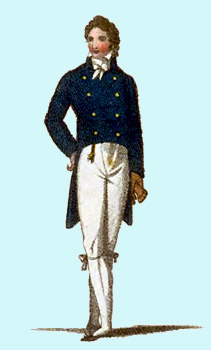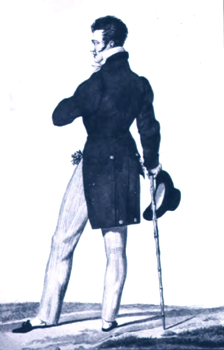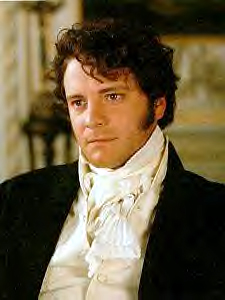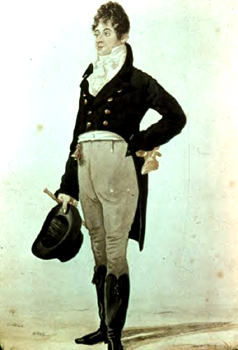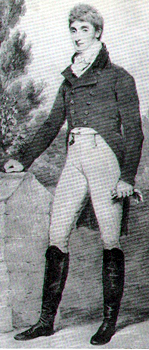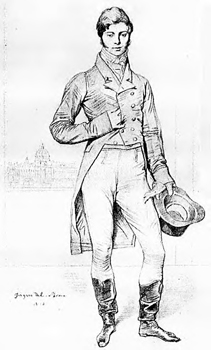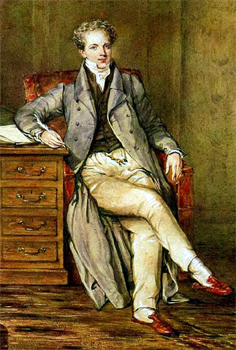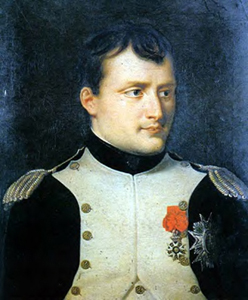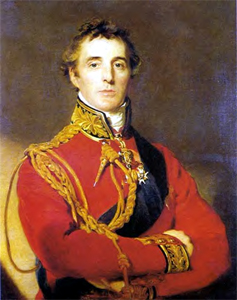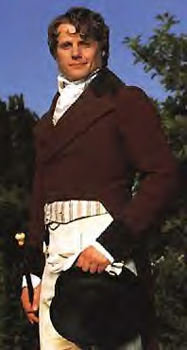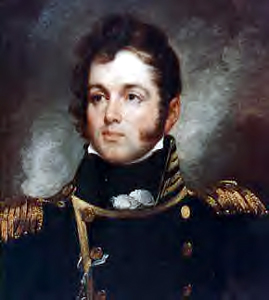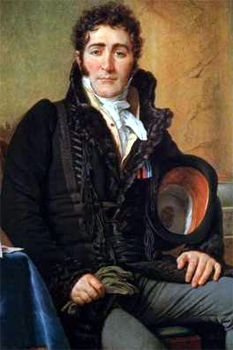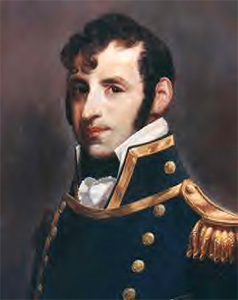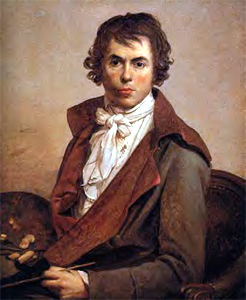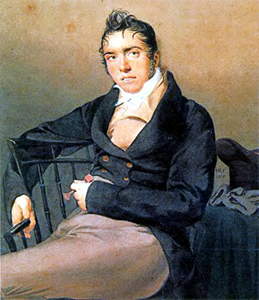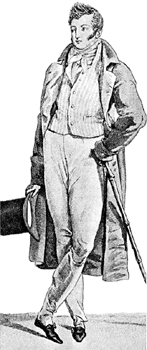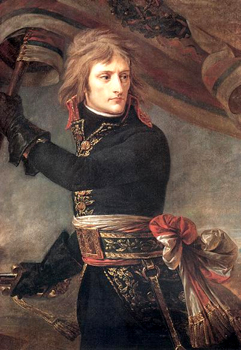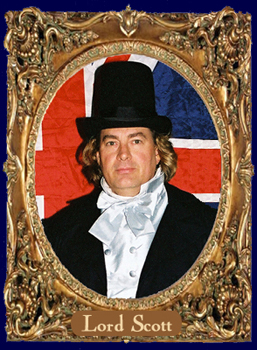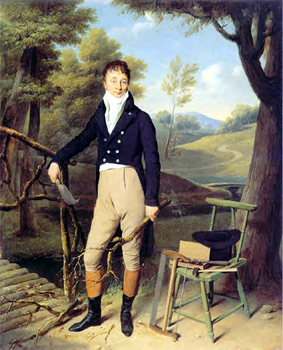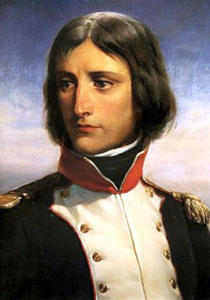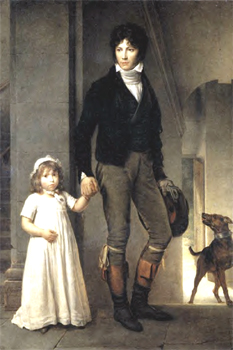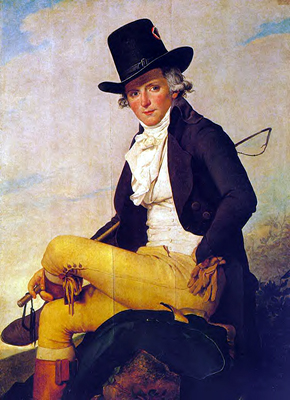The roots of gentlemen's fashions of the Regency era of circa
1795-1825 traced
back primarily to two sources. One was the equestrian clothing of English
"country gentlemen" of the late
18th century and the other was the radical new designs which came out of the
French Revolution. Though most clothing of the era appears to be quite formal
and conservative to us (and in fact one could argue that modern men's formal
and business attire trace their roots to this era), in actuality there were
some very abrupt departures from what had developed over the past century and
a half during the Baroque and Georgian periods. Breeches (which had been
standard men's attire in one form or another for at least two centuries) were
slowly abandoned in favor of pantaloons and trousers. Bright colors and
gaudy accoutrements gave way to the new idea (propagated by persons such as
fashion icon Beau Brummel) that a gentleman of taste ought to be subtle and
subdued, leaving brilliancy in color and accessories for the most part to the
ladies. With a few subcultural exceptions this philosophy
has pretty much carried forward even to the present day.
The following information on clothing is introductory in nature and will help you to gain
a feel for the era. But as with any historic period, in order to accomplish an
accurate portrayal you will need to do further research based on a more exact
time, place and type of person.
Tailcoat:
The tailcoat was the de rigueur article of clothing for any man of at least
middle class standards. It was high in the back of the neck, fitted in the
back, chest and abdomen, had long tails and the wide “M notch” lapels so distinctive
of the period. It could be either single or double breasted and could be
worn open or closed. It was cut high in front so that even when closed
a strip of the waistcoat could be seen beneath. This cut was in the form of an
arch earlier in the period and was more horizontal later.
The tailcoat was usually made of wool though sometimes of linen for warm
climates and seasons. There were many color options for daywear but for
evenings conservative darker ones such as black and navy were most
fashionable, a trend which has continued to this day. Buttons could be
self-fabric covered or of brass or pewter.
Waistcoat:
The waistcoat was made from wool, linen or silk and could be a solid but was
often a brocade, stripe or pattern. It had a high, stand-up collar and
sometimes wide turn-back lapels, especially earlier in the period. The
waistcoat extended below the front of the tailcoat and covered the top of the
trousers or breeches. It was most often single breasted but could be double
breasted as well.
Shirt:
The shirt was usually of linen or cotton. It was long and loose fitting with
off the shoulder sleeves and a high standing collar that extended up sometimes
even above the jaw line. The shirt had a slit in the front and pulled on over
the head. It was mid-thigh to knee length and was quite often the only
undergarment. Ruffles at the sleeves were unpopular during this period (viewed
as old-fashioned and undemocratic) but ruffles at the chest were still an
option.
Breeches, Pantaloons and Trousers:
Breeches were gradually fading out during this period. For a time they
remained the proper item for evening wear then were relegated to only very
formal occasions and then survived only as “court” apparel for certain royal
occasions. Breeches could be made of wool, cotton, linen or silk with the
latter best for the most formal events. They tended to have a higher waist in
front and a little less baggy seat than the late 18th century version.
However, they still had a drop front, were fitted in the thighs and buckled or
buttoned just below the knees.
Pantaloons were popularized early in the 1790s by French revolutionaries.
They had a drop front, were anywhere from mid-calf to ankle length and were worn exceedingly
snug.
Trousers became commonplace during the Regency era and we still wear their
descendants today. The trousers had a high waist that came up at least to the
navel. They were drop front and were held up by means of braces (suspenders).
They were worn much looser than pantaloons though they were often fitted down
at the ankles, sometimes using gussets so that they could come down quite low
onto the shoes. Trousers could be of wool, linen or cotton. Though initially
only appropriate for daywear they eventually gained acceptance for evening
attire as well.
Neckcloth:
The neckcloth or cravate was a necessary accessory. Typical of this era was a
long, narrow strip of linen or silk which wrapped several times around the
neck and was then tied in front. Many forms of tying were popular, some
considered more formal and others most suitable for casual wear.
Hats:
A very tall, straight top hat with a narrow curled up brim was the height of
fashion during much of this period. The bicorn was high, wide and of shallow
depth. It was popularized as a military fashion and was worn by Napoleon,
though some civilians wore it too. Many specialized types of headwear were in use as well
such as the flat, round hats of sailors, the shakos of soldiers or the
coonskin caps of American frontiersmen.
Hair:
Perhaps the most well known men’s hairstyle of the Regency era was short to
medium at the sides and back but longer on top where the hair was often
brushed upwards for height. Sometimes the hair was cut short all the way
around and combed forward on the sides. Short curly bangs and curls at the
sides of the face above the ears were also fashionable. Some men did wear
their hair long, particularly on the European Continent. Sideburns became increasingly
common. Otherwise, virtually all men were clean shaven. Moustaches were worn by
a few
(mostly German) military officers. Beards or goatees would not be worn by anyone for several
more decades. Wigs were still common in the early part of the era but their use
had all but disappeared by the end.
Shoes, Boots and Stockings:
Buckled shoes gradually went out and lace up shoes came in. Light slip on
shoes sans the buckle were popular as well. Most shoes would
be black and of leather. Both low cut shoes and ankle high bootees were worn.
Boots were high and of black or brown leather. "Bluchers," "Wellingtons" and
an ubiquitous style very like modern English riding boots were all used.
Stockings were long and of wool, cotton or silk.
Accessories:
Gloves, canes, pocket watches, watch fobs and wallets of leather or fabric all
enjoyed wide usage. Swords were not normally carried by civilian men. Long
overcoats with collar and lapels styled similarly to the tailcoat came into
fashion as "undress" for cold or inclement weather.
Uniforms:
This era which saw the Napoleonic Wars and War of 1812 was arguably the most
brilliant and colorful in the history of martial attire what with bright hues,
high standing collars, tall shakos and glittering braid and trim. If desirous
of a military portrayal of this period one will need to research as per
specific person, regiment or branch of service of interest.
© 2001-2006 Note: This article and this web page are the copyrighted property
of the author and may not be copied or reproduced in part or in whole except by express written
permission.
We Make History -
Main Page
Email to Lord Scott
A Regency Era Primer
Ladies' Fashions of the Regency Era
The Pride & Prejudice Ball
